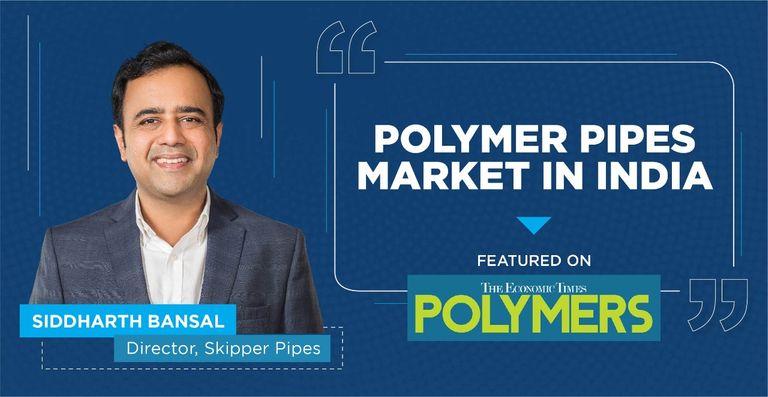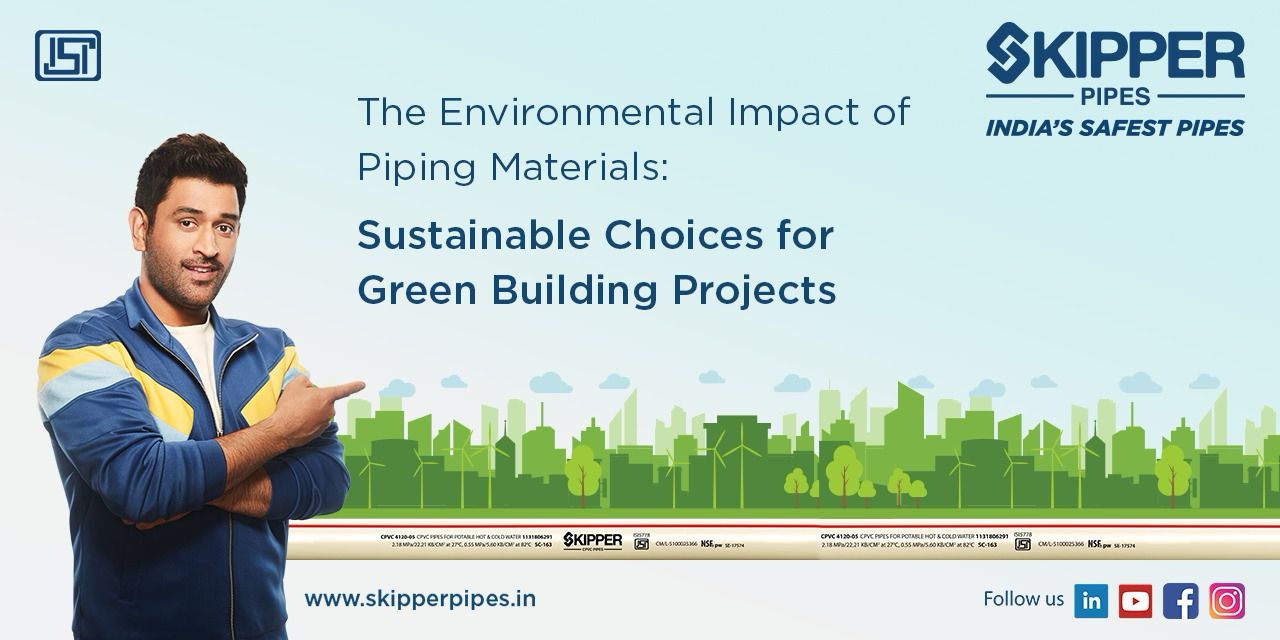The article offers an elaborated view of India’s plastics and polymers market, global trends, government support, challenges, and outlook.
By Siddharth Bansal, Director, Skipper Pipes
Featured on The Economic Times Polymers magazine April-May 2022 issue.
Polymer pipes are essentially plastic pipes, and they have been around since the early 20th century. However, around the mid-20th century, say post-1950s, polymer pipes underwent stronger development due to technological advancements and innovations in pipe fittings and technologies. Ever since polymer pipes have entered the global market, it has gradually transformed how our plumbing system is designed.
Polymer pipes quickly replaced metal pipes as they were more affordable and corrosion-resistant. Today, polymer pipes are used for numerous purposes in a host of industries, which includes facilitating water supply to homes, irrigation, vacuum and pressure systems, drainage and sewage systems, manufacture of advanced fire-sprinkler systems, infrastructure for the conveyance of chemicals, heating and cooling fluids, food products, and of many forms of gaseous or liquid fluids.
Although polymer pipes are most commonly known due to polyvinyl chloride (PVC) pipes, other forms of plastic pipes are available for specific purposes. For instance, acrylonitrile butadiene styrene polymer pipes conveyance for chemicals and slurries; polybutylene or PB-1 is used in pressure piping systems for hot and cold-water pressure; and so on.
Global and local polymer pipes market
In the new normal India, the polymer pipes sector has been doing rather good, despite the pandemic impact. A significant shift has happened in demand for the metal to polymer pipes in various sectors, including plumbing and piping applications in the construction industry. CPVC pipes are increasingly being used for hot and cold-water plumbing, and the sector has witnessed strong growth in the usage of these pipes.
The major players in the industry, who have the highest market capitalisation, have reported a year-on-year 3 to 11 per cent CAGR growth in the past two years. As per CRISIL, the PVC pipes makers are projected to make a record 35 per cent surge in FY2022. Globally, the pandemic has impacted the market of plastic pipes, which is estimated to be $29.9 billion in 2022. However, considering market corrections due to the pandemic means the sector would grow at a CAGR of 5.6 per cent by 2026, achieving a size of $38.1 billion.
In India, the plastic pipes industry is around Rs 400 billion. In the past five years, through the pandemic, it has scripted a 10 per cent CAGR from FY2016 to FY2021. The sector is projected to record a slightly higher growth rate of 12 per cent and achieve Rs 550-600 billion by FY 2025. The organised players in the sector account for approximately 67 per cent of the market in FY 2021.
The government impetus
Our country is amongst the biggest consumers of CPVC pipes and fittings products. Furthermore, under the visionary leadership of Prime Minister Narendra Modi, the government has initiated “Har Ghar Jal Yojna” and “Jal Jeevan Mission”, intending to make tap water accessible to all rural households in India. One of the most significant steps taken by the government is the Jal Jeevan Mission (JJM) initiative, which aims at providing tap water connections to all rural households by 2024.
With the growing need for clean water in all residential and commercial projects, the plumbing pipes and fitting product segment will witness stronger demand and growth. This has strongly pushed the demand for PVC pipes and fittings to support water flow in each home. The PVC and Fittings market was estimated to be around Rs 300 billion in FY2020. With a CAGR of 10.8%, the sector could surpass Rs 500 billion by FY2025.
Indirect growth accelerators
Pursuing the mission of Atmanirbhar Bharat, the Government policies are directed toward national development, which has self-reliance at its core. The government’s support of the sector will play an instrumental role in its growth. While direct policies amplify the sector’s development, several indirect policies create growth avenues. The government has levied Anti-Dumping Duty on CPVC resin/compound imports from China and Korea from 2020 to 2025. This move is benefiting the local players directly.
The government has strongly focussed on designing various institutional structures. It has boosted the efforts to monetise assets to achieve the National Infrastructure Pipeline (NIP) goals. Consequently, it has allocated capital expenditure of 5.5 trillion for FY2022. Several Government initiatives, which may not be directly related to the polymer pipes segment, are contributing to the sectoral growth in a big way. The Nation Monetization Pipeline is focused on strengthening infrastructure in urban India.
There is a growing focus on rural infrastructure development, which is creating newer markets for polymer pipes. The expansion of railways, airports, roadways and highways, and the agricultural sector is creating demand for polymer pipes in India. Another big growth accelerator focuses on reviving the affordable housing sector and urban planning. Other sectors adding to the demand include automotive, electrical and other end-use industries, oil and gas, and petrochemicals. The developmental focus of the Indian government has therefore presented the sector with a growth roadmap and numerous opportunities.
Challenges, opportunities, and trends
The polymer pipes market is not without its challenges. However, challenges provide opportunities for innovation, which further leads to trends. The following are some of the macroscopic challenges, opportunities and likely trends which can impact the sector.
Global uncertainties. The world is facing several global uncertainties, including threats of climate change. For the past two years, the more urgent crisis has been the pandemic which has ravaged economies in waves. In India, post the third wave, the economy is at a full upswing. However, it is still premature to rule out a future wave that can affect value and supply chain, lead to container shortages, inflate the cost of crude oil, and affect international trade. The polymer pipes sector in FY2021 witnessed a strong rise in PVC prices due to these constraints and high demand for the product, and increased shortages. While this is unlikely to repeat, international geopolitics and conflicts have further disrupted industry, trade, and economies worldwide. Although the Indian polymer sector is largely protected, it may have some impact in the time to come. Any inflation in manufacturing costs will eventually get passed on to the customer.
Mixed imports and sourcing of raw materials
India sources key raw materials for the polymer market from various countries. The majority of the raw materials are connected with the state of crude oil in the international market. While domestic petrochemical companies provide a significant share of raw materials to the industry, most products are sourced from countries like UAE, Saudi Arabia, Qatar, Korea, Taiwan, Japan, China and Europe. As we advance, India has a tremendous opportunity to create avenues for manufacturing raw materials in the country. Localisation will be a significant trend going forward. We need to rethink our dependency on imports from other countries, considering volatile geopolitical and economic situations for it to happen.
Industry consolidation:
The polymer pipes sector is fragmented, with the lesser-known and smaller players sharing a significant part of the market. However, the players have a low propensity to endure, adapt, and upgrade against various uncertainties. This has led to some consolidation in the sector.
Lower usage of lead:
There is a growing focus on minimising or abating lead usage for manufacturing polymer pipes. PVC pipes are the most common sources of lead contamination in drinking water supplied to the home. Consequently, the government has mandated a BIS license from March 2022 (extended deadline) to control the quality of pipes and contain lead usage in the industry. It will further declutter the sector and will lead to higher consolidation. This is because smaller players would have to upgrade machinery, and product quality, apply for and purchase licenses, and incur other capital expenditures, which will increase the cost of production drastically.
Use of Calcium and Zinc:
The industry will also switch to an increased usage of calcium and zinc instead of lead, reducing the efficiency of older machines by 15 to 20%. This will further require the players to upgrade their plant and machinery in the short term. The bigger players will continue to consolidate and gain market share, while the smaller players will need Government support and incentives to stay in the competition.
The polymer pipes industry has strong growth drivers in various development sectors, including building and construction, automotive, oil and gas, urban and rural planning, etc. The industry has witnessed constant growth in the near past. By FY2018-2019, the Pipes Industry had achieved an estimated value of Rs 300 billion. Its sub-segments, fittings have over 20 per cent margins, followed by CPVC with 16-18 per cent and PVC plumbing range with 12-13 per cent.
With a 73 per cent share of the market, the PVC pipes and fittings segment is expected to grow during FY 2019-2026. It is anticipated that the sector will record a double-digit CAGR growth of 14 per cent by revenue. While the sector continues to become cleaner and greener in its design of products and addressing customers’ needs, the industry will continue to consolidate, and organised players will gain a stronger market share.



0 Comments